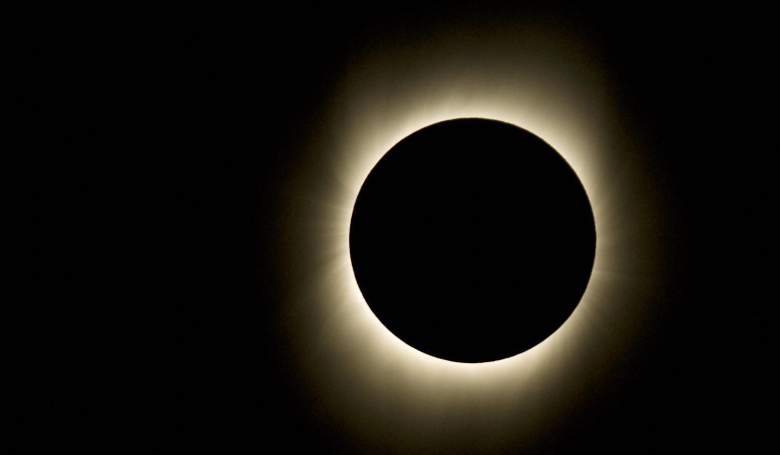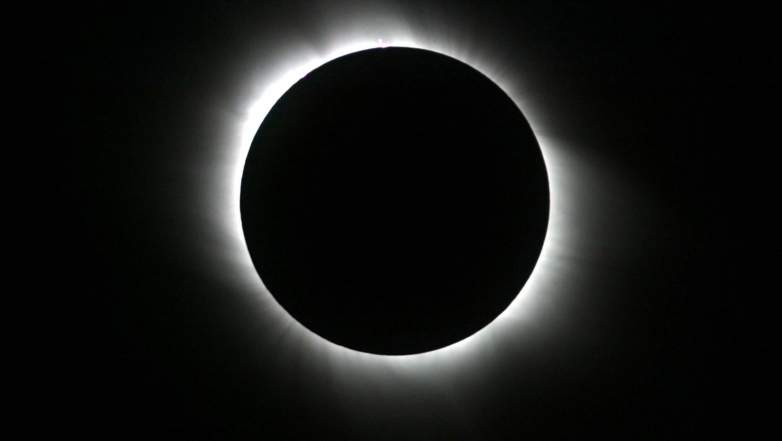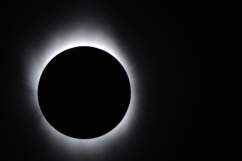
Chicago is not in the total eclipse zone. However, that doesn’t mean you don’t have a rare opportunity to experience the beauty of the Great American Solar Eclipse.
The Illinois city will soon experience a partial solar eclipse.
“On Monday, August 21, 2017, all of North America will have a solar eclipse. The Moon will cover at least part of the Sun for 2 to 3 hours,” the American Astronomical Society explains. “Halfway through, anyone within a narrow path from Oregon to South Carolina will experience a brief total eclipse. The Moon will completely block the Sun’s bright face for up to 2 minutes 40 seconds. Day will turn into night, and (weather permitting) one of nature’s most awesome sights will become visible: the Sun’s diaphanous outer atmosphere, or corona.”

GettyA total solar eclipse in 2006.
According to NASA, the “total eclipse” path, “where the moon will completely cover the sun and the sun’s tenuous atmosphere – the corona – can be seen, will stretch from Lincoln Beach, Oregon to Charleston, South Carolina. Observers outside this path will still see a partial solar eclipse where the moon covers part of the sun’s disk.”
Here’s what you need to know:
ECLIPSE TIME:
The Courier Journal has a great interactive website that allows you to look up eclipse information that is specific to city. “The moon will be in the sun’s path starting at 11:54 a.m. and continue for 2 hours 48 minutes. The best time to see the peak of the eclipse will be 1:19 p.m.,” the site reports of Chicago.
TimeandDate is a similar site that allows you to see information specific to Chicago but also shows you how close the city will get to the total solar eclipse’s path (it’s pretty close.) The site reports of Chicago: “Partial begins: Aug 21 at 11:54:19 a.m. Maximum: Aug 21 at 1:19:47 p.m. Partial ends: Aug 21 at 2:42:37 p.m.”
DEGREE OF ECLIPSE:
Expect to see the moon cover 86.7% of the sun. The Chicago Tribune has created a compelling graphic above that demonstrates how much of an eclipse Chicago will see.
You can learn more about the differences between total and partial solar eclipses here:
WEATHER:
Weather is a factor in how well you will be able to see the solar eclipse (and remember to use proper solar eclipse glasses and do not look at the solar eclipse if you don’t have them. It could cause serious eye damage, according to NASA).
Chicago’s weather at 11 a.m. on August 21, 2017 was 80 degrees with mostly cloudy weather, according to Weather.com.
PATH OF TOTAL ECLIPSE:
How close will the total eclipse get to Chicago? You can watch the video above. It shows the path of the total eclipse, which will touch 14 states.
The path does cross over part of Illinois, just not Chicago:
Carbondale, Illinois is considered a great place to see a total solar eclipse. The duration of the eclipse in Illinois is reported to be two minutes and 40.3 seconds, but Carbondale is reported to be getting 2 minutes and 35 seconds of totality.
Read more about Carbondale here:
ADDITIONAL DETAILS:
You can look up solar eclipse times and other information by zip code and city here.
If you didn’t get solar eclipse glasses, don’t risk your eyes. Here are instructions for a fun DIY viewing box that will allow you to experience the grandeur of the eclipse without looking at the sun.

